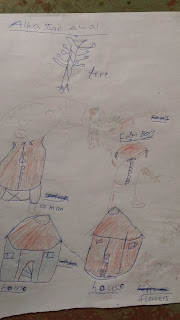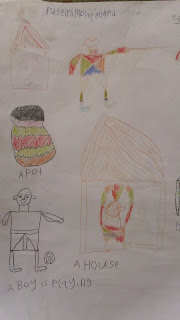
The students drawing their pictures.

Mr. Babamo talking to the students.

The students with their final works of art. We took pictures of a few so you could see all of their hard work.















We may have a new favorite holiday! Last week was the Dagomba fire festival, Bugum Chugu. To celebrate,the whole village assembles in front of the chief's palace around eight. Everyone has long torches made of bound grass. The kids in each family spend the day making them for their relatives. Our counterpart Ibrahim's children made them for us. The drummers begin to drum to announce the arrival of the elders. Traditionally the chief would come out and light the first torch, but since our chief is sick, one of the elders started ours. Then everyone lights their torch off of the first one and begins to march through town, singing and dancing. The young men of the village are at the heart of the parade with the drummers, dressed in traditional clothes. There faces are covered in ash and they carry machetes, guns, tools, or juju sticks. Every so often the parade will stop moving and the young men will test their strength by screaming and pushing each other over. It is really crazy and the women, children, and everyone else backs away during this time. At the end of the procession there is a tree in which everyone throws their torch on to light it on fire. After the tree is set on fire everyone walks back to the village. They gather fresh branches from shea and neem trees raising them while singing and dancing all the way to the chiefs palace. After the chief's palace, the drummers lead everyone to different compounds. People run into the compounds and water is thrown on them. We went all through the village, sprinting through the dark. It was a blast. Living in a village with no electricity made this celebration that much cooler. So our videos kind of really suck, because it was so dark and dusty. Also it is really difficult to film while holding a giant torch and it was way more exciting to participate than record it. We went ahead and posted them for you to look at. There is no way to show how amazing this was.

This is the garden/farm just as we began weeding

Here are two beds we built

Scott and Ibraheam harvesting aleefu from one of the beds a few monthes later

Jennifer with Ibraheam carrying aleefu to be sent to Tunayili school



 The kids made cards for people living with HIV in the hospital
The kids made cards for people living with HIV in the hospital 
This guy processes honey across the street from our house. They call him "the muscles." He is with our closest Peace Corps nieghbor Katy.

 The bat spin- first you spin around the bat three times then carry a book on your head. These kids have been carrying things on their head since they could walk. It really wasn't much of a challenge.
The bat spin- first you spin around the bat three times then carry a book on your head. These kids have been carrying things on their head since they could walk. It really wasn't much of a challenge. Prayers on the soccer field
Prayers on the soccer field Scott and Jennifer with the Cheif
Scott and Jennifer with the Cheif Slaughtering a ram
Slaughtering a ram


Next the cracked nuts are milled. Then the women roast the nuts over an open fire.

It is mixed for about an hour. We both mixed some and it is very tiresome. Our shoulders started hurting after only 5 minutes. After about an hour the shea butter will separate from the water.

Then they skim off the shea butter and put it back on the fire. It is cooked until it boils.
Although it looks black and nasty when it is cooked, when it cools it will look a creamy white color. It can be used for your body or to cook with. It is a pretty amazing process.
 We visited a women's shea processing group in the Upper east. This is some women crushing the boiled and dried nuts. They sang and danced the whole time they were working. They were truely amazing. We have some video we hope to upload when we get a faster connection.
We visited a women's shea processing group in the Upper east. This is some women crushing the boiled and dried nuts. They sang and danced the whole time they were working. They were truely amazing. We have some video we hope to upload when we get a faster connection.
 This is the Sirigu pottery center. It was started to raise money for school fees for local girls. They offer art classes to generate extra money.
This is the Sirigu pottery center. It was started to raise money for school fees for local girls. They offer art classes to generate extra money.
 Here is some of the pottery. They sell these pots for less than 5 US dollars. Most of the crafts people do here they drastically undersell because they do not factor in labor or time.
Here is some of the pottery. They sell these pots for less than 5 US dollars. Most of the crafts people do here they drastically undersell because they do not factor in labor or time.
 Here is Jennifer sitting on her very first crocodile in Paga!
Here is Jennifer sitting on her very first crocodile in Paga!
 Scott drinking real coffee out of official US China
Scott drinking real coffee out of official US China
 bathing bucket for Mel This is the one of the cleanest showers we have had.
bathing bucket for Mel This is the one of the cleanest showers we have had.
 Wli Falls, the largest waterfall in Western Africa.
Wli Falls, the largest waterfall in Western Africa.
 Jennifer stirring Fufu with our host mom Jennifer Owusea
Jennifer stirring Fufu with our host mom Jennifer Owusea
 Banku, boiled plaintain, ocro stew, and wakye
Banku, boiled plaintain, ocro stew, and wakye
 Our house in Dipale. It is totally the nicest house in the village, most people live in compounds of round mud hut that open up into a courtyard.
Our house in Dipale. It is totally the nicest house in the village, most people live in compounds of round mud hut that open up into a courtyard.